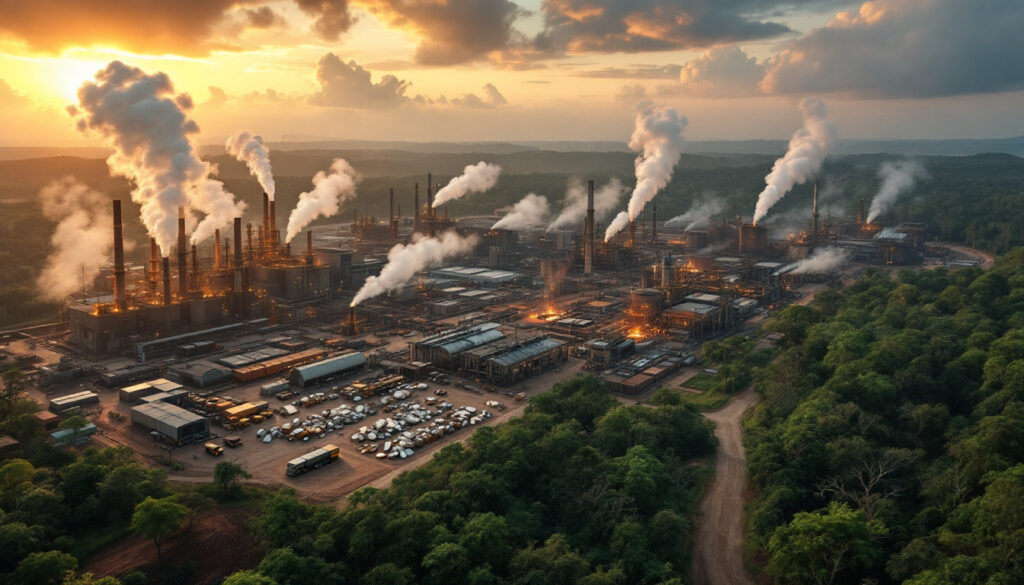Indonesia's Nickel Boom Is Forcing Its Own Smelters to Shut Down
Indonesia's nickel industry, which rapidly ascended to control over 50% of global production through aggressive government policies and Chinese investment, now faces systemic collapse. A 40% price decline since 2023, coupled with ore shortages and shifting battery chemistry preferences in China, has rendered more than half of Indonesia's nickel pig iron furnaces unprofitable. Major smelters like PT Gunbuster Nickel Industry have neared full shutdowns amid liquidity crises, while Australian-listed Nickel Industries Ltd. reported a $205 million impairment. This report analyzes the structural imbalances caused by production overexpansion, evolving lithium iron phosphate (LFP) battery adoption, and geoeconomic tensions reshaping global commodities outlook.
The Paradox of Oversupply in a Dominant Market Position
Production Capacity vs. Global Demand Dynamics
Indonesia's nickel output surged from 760,000 metric tons in 2020 to 1.8 million metric tons in 2024, achieving 54% global market share. However, this 137% production increase coincided with a 22% decline in stainless steel demand from China—the sector consuming 70% of nickel. The mismatch created a 340,000-ton global surplus in 2024, cratering prices to $16,500/ton, below the $18,000 break-even point for 62% of Indonesian smelters. Understanding these market dynamics explained helps investors contextualize the current crisis.
Operational Geography and Logistical Fractures
Smelters in Java incur $38/ton transport costs for Sulawesi-mined ore, versus $12/ton for Sulawesi-based facilities. This 216% cost disparity forced 73% of Java's 28 smelters to operate below 40% capacity by Q1 2025. Even Tsingshan Holding Group's Morowali Industrial Park—hosting 42 furnaces—reduced output by 19% year-over-year, demonstrating the crisis's sector-wide reach.
Policy-Driven Expansion Meets Technological Disruption
The Downstreaming Strategy's Contradictions
Indonesia's 2020 ore export ban successfully boosted smelter count from 15 to 43, but incentivized excessive investment in nickel pig iron (NPI) capacity geared toward stainless steel. When EV battery demand plateaued due to LFP dominance (rising from 30% to 62% of Chinese EV batteries 2022-2025), the planned pivot to battery-grade nickel failed to materialize. Only 12% of Indonesia's nickel production currently meets battery specifications.
Chinese Technological Prowess and Its Recoil
Tsingshan's patented rotary kiln electric furnace (RKEF) technology enabled processing of Indonesia's low-grade laterite ores (<1.8% Ni content), but also accelerated oversupply. China's NPI output reached 480,000 tons in 2024—85% from Indonesian ores—flooding markets despite Beijing's property sector crisis reducing stainless steel orders by 18%. According to Bloomberg, this imbalance has created unprecedented pressures on the industry's structure.
Sectoral Impacts and Financial Contagion
Corporate Case Studies in Crisis
-
PT Gunbuster Nickel Industry: This Jiangsu Delong subsidiary delayed $47 million in supplier payments before idling 18 of 22 furnaces in March 2025.
-
Nickel Industries Ltd.: The Australia-listed firm's EBITDA margin contracted from 34% (2022) to -7% (2024), reflecting sector-wide margin collapse.
-
Tsingshan's Strategic Pullback: The nickel giant postponed Phase III expansion at Weda Bay, slashing planned capacity additions by 120,000 tons.
Financialization and Debt Overhang
Indonesian nickel firms face $6.7 billion in collective debt coming due through 2026, with average interest coverage ratios falling below 1.5x. The sector's average debt-to-EBITDA ratio ballooned to 5.8x in 2024, exceeding the 3.0x threshold considered sustainable for commodity cyclicals. This financial pressure has profound implications for mining investment fundamentals across the region.
Demand-Side Erosion and Market Realignment
Battery Chemistry's Pivot Away from Nickel
Contemporary Amperex Technology Co. (CATL) now produces LFP batteries with energy densities matching nickel-rich NMC varieties, causing nickel's battery market share to drop to 38% in 2024. This shift erased 220,000 tons of anticipated nickel demand, equivalent to 12% of Indonesia's nickel boom and smelters shutdown production. The ASEAN Briefing notes this technological disruption was unforeseen by Indonesian policymakers.
Stainless Steel's Delayed Recovery
China's property sector—which drives 40% of stainless demand—remains mired in a liquidity crisis, with 23% of pre-sold residential projects delayed. Despite a 15% production cut by Tsingshan and Guangqing Group, stainless steel inventories hit a record 3.2 million tons in February 2025, suppressing nickel prices.
Pathways to Rebalance and Recovery
Government Intervention Scenarios
Jakarta's proposed mine supply cuts (20-30% reduction) could remove 360,000-540,000 tons of annual ore supply. However, Macquarie estimates a 550,000-ton global deficit is needed to stabilize prices above $20,000/ton—a 38% increase from current levels. Implementing effective geopolitical market strategies will be crucial for investors navigating this transition.
Vertical Integration and Product Diversification
Only 8 Indonesian smelters currently produce mixed hydroxide precipitate (MHP) for batteries. Expanding this capacity requires $2.1 billion in new investment to retrofit NPI furnaces—a challenging prospect given current credit conditions. Before undertaking such investments, companies are conducting thorough economic viability studies to evaluate risk profiles.
The Looming Consolidation Wave
Analysts anticipate 40% of Indonesia's smelters will undergo mergers or acquisitions by 2026, with Tsingshan and Zhejiang Huayou Cobalt likely to acquire stranded assets. This consolidation could raise industry capacity utilization from 63% to 85%, restoring marginal profitability.
Conclusion: Nickel's New Reality
Indonesia's nickel crisis exemplifies the perils of export-oriented industrialization in volatile commodity markets. While the country's resource endowment and low-cost position provide long-term advantages, the industry must navigate a painful transition period marked by capacity rationalization and product diversification. The success of Jakarta's downstreaming ambitions now hinges on attracting $3.4 billion in battery-grade nickel investments while managing short-term financial instability. How Indonesia balances these competing priorities will determine whether it emerges as a sustainable EV metals hub or remains entrenched in cyclical boom-bust dynamics.
Searching for Investment Opportunities in the Nickel Sector?
As Indonesia's nickel industry undergoes significant restructuring amidst oversupply and price declines, investors need timely insights to navigate this volatile market effectively. Discover high-potential ASX mining opportunities with Discovery Alert's proprietary Discovery IQ model at discoveryalert.com.au/discoveries, providing real-time alerts to position yourself ahead of market movements.




